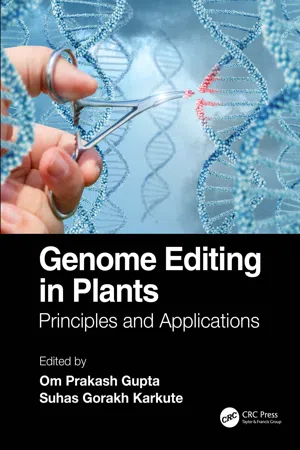
Genome Editing in Plants
Principles and Applications
- 250 pages
- English
- ePUB (mobile friendly)
- Available on iOS & Android
Genome Editing in Plants
Principles and Applications
About this book
Genome Editing in Plants: Principles and Applications addresses the information of genome editing starting from principles and historical aspects to the latest advancements in the field. As genome-editing technology has emerged as promising and cutting edge, researchers around the world have started producing original research outputs, which have significantly improved our current understanding and potential of this technology. The initial chapters of this book describe different genome-editing tools as well as their principles and applications. Other chapters are dedicated to the present status and future applications of genome-editing techniques in various crop improvement programmes. Some of the advanced applications of CRISPR/Cas tools, such as base editing and RNA detection, along with regulatory aspects of genome-edited crops are described in detail.
This book serves as a valuable resource to researchers in the field of crop improvement; graduate and postgraduate students engaged in plant molecular biology and biotechnology; academicians; and policy makers.
Key Features:
-
- Addresses topics associated with historical development and principles of genome-editing technology
-
- Addresses basic mechanisms operating under each genome-editing technology
-
- Addresses its application in plants to design crops as per the current and future demands
-
- Addresses the regulatory mechanisms of genome-edited crops
Frequently asked questions
- Essential is ideal for learners and professionals who enjoy exploring a wide range of subjects. Access the Essential Library with 800,000+ trusted titles and best-sellers across business, personal growth, and the humanities. Includes unlimited reading time and Standard Read Aloud voice.
- Complete: Perfect for advanced learners and researchers needing full, unrestricted access. Unlock 1.4M+ books across hundreds of subjects, including academic and specialized titles. The Complete Plan also includes advanced features like Premium Read Aloud and Research Assistant.
Please note we cannot support devices running on iOS 13 and Android 7 or earlier. Learn more about using the app.
Information
1 Historical Developments of Genome Editing in Plants
Dr. Panjabrao Deshmukh Krishi Vidyapeeth
1.1 Genesis
Year | Major Discovery |
|---|---|
1978 | Ishino and colleagues for the first time observed an unusual repetitive sequence activity in bacteria |
1979 | In vitro genome editing with the replacement of chromosome segment with other DNA sequence |
1985 | Identification of zinc-binding domain in protein transcription factor |
1987 | CRISPRs, first described as a bacterial immune system in Escherichia coli |
1989 | Studied the double-stranded break repair and recombination mechanism in yeast |
1993 | Francisco Mojica was the first to characterize what is now called a CRISPR locus |
1996 | Use of hybrid restriction enzyme including zinc finger and FokI cleavage domain |
2001 | Spanish researchers at University of Alicante proposed the name CRISPR |
2005 | Discovered the involvement of CRISPR as a form of adaptive immunity in bacteria and the discovery of Cas9 and PAM sequences |
2007 | Experimental demonstration of adaptive immunity of CRISP-Cas9 in bacteria |
2008 | Spacer sequences are transcribed into guide RNAs (crRNAs) and CRISP target DNA |
2009 | Identified action of TAL-type III effecters in Xanthomonas |
2010 | Role of type II, CRISPR-Cas identified |
2011 | Discovery of tracrRNA for Cas9 system |
2012 | Duodna and Charpentier use the CRISPR-Cas9 system as a tool for genome editing, by employing genetically engineered CRISPR-Cas system |
2013 | First-time demonstration of use of the CRISPR/Cas system for genome editing in plants, humans and other eukaryotic |
2015 | DNA-free genome editing technique in plants |
1.2 Techniques for Genome Editing
1.2.1 Cre-Lox System
1.2.2 Meganucleases
Table of contents
- Cover
- Half Title
- Title Page
- Copyright Page
- Dedication
- Table of Contents
- List of Figures
- List of Tables
- Preface
- Editors
- Contributors
- Chapter 1 Historical Developments of Genome Editing in Plants
- Chapter 2 Mechanism of ZFN-Mediated Genome Editing: Scope and Opportunities
- Chapter 3 TALENs: Customizable Molecular Scissors for Tailoring Newer Types of Genomes in Plants
- Chapter 4 Mechanism of CRISPER/Cas9-Mediated Genome Editing: Scope and Opportunities
- Chapter 5 Genome Editing for Improvement of Wheat and Millets
- Chapter 6 Genome Editing for Improvement of Rice
- Chapter 7 Genome Editing Using CRISPR/Cas Systems in Legumes
- Chapter 8 Genome Editing in Oilseed Crops
- Chapter 9 Towards ‘CRISPrY’ Vegetables: Status of Genome Editing in Vegetable Crops
- Chapter 10 Genome Editing in Fruit Tree Crops: Prospects and Challenges
- Chapter 11 Genome Editing for Metabolic Engineering in Plants
- Chapter 12 Genome Editing in Algae: Perspectives and Challenges
- Chapter 13 Plant Genome Editing in Basic Research to Understand Molecular Functions
- Chapter 14 Genome Editing in Plant: Challenges and Opportunities
- Chapter 15 Regulatory Approaches for Genome-Edited Crops
- Chapter 16 Advances in Genome Editing
- Index